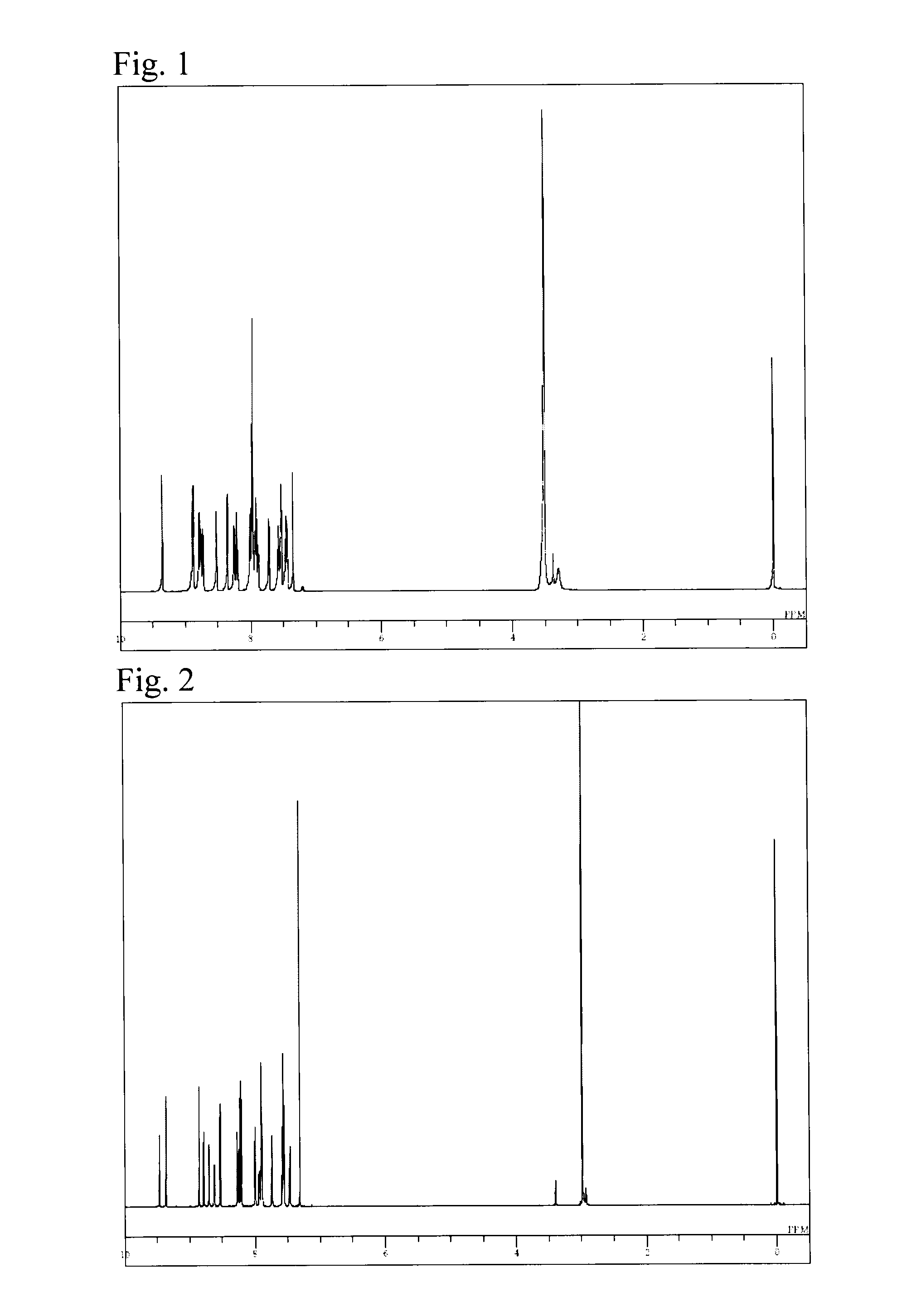Compound having pyridoindole ring structure bonded with substituted pyridyl group, and organic electroluminescent device
a pyridoindole ring and pyridyl group technology, applied in the direction of electroluminescent light sources, organic chemistry, thermoelectric devices, etc., can solve the problems of reducing efficiency, taz has a great problem of low electron transport property, and cannot be considered that the material has hole-blocking capability, etc., to achieve excellent hole-blocking ability, excellent thermal resistance, and high luminous efficiency
- Summary
- Abstract
- Description
- Claims
- Application Information
AI Technical Summary
Benefits of technology
Problems solved by technology
Method used
Image
Examples
example 1
Synthesis of 4′-(naphthalen-2-yl)-6-(5H-pyrido[4,3-b]indol-5-yl)-[2,2′;6′,2″]terpyridine (Compound 27)
[0072]A reaction vessel was charged with 11.0 g of 2-acetyl-6-bromopyridine, 14.0 g of iodine, and 45 mL of pyridine, followed by heating and stirring at 100° C. for 5 hours. After cooling to room temperature, 100 mL of water was added thereto and purification by recrystallization was performed. The reaction product was vacuum-dried at 70° C. for 12 hours to obtain 13.8 g (yield, 62%) of [2-(6-bromopyridin-2-yl)oxoethyl]pyridinium iodide as a brown powder.
[0073]Subsequently, 25.8 g of 2-naphthaldehyde, 20.0 g of 2-acetylpyridine, and 250 mL to methanol were mixed together, and the mixture was cooled to −5° C. with stirring. Thereto was added dropwise 250 mL of 3 wt % NaOH / methanol solution, followed by stirring at −5° C. for 3 hours and then further carrying out a reaction at the same temperature for 1 day. The crude product was collected by filtration and then washed with methanol ...
example 2
Synthesis of 4′-(naphthalen-2-yl)-6-(5H-pyrido[4,3-b]indol-5-yl)-[2,2′;6′,3″]terpyridine (Compound 131)
[0078]As in Example 1,3-(naphthalen-2-yl)-1-(pyridin-3-yl)propenone was synthesized from 2-naphthaldehyde and 3-acetylpyridine, and further subjected to a reaction with [2-(6-bromopyridin-2-yl)oxoethyl]pyridinium iodide to synthesize 6-bromo-4′-(naphthalen-2-yl)-[2,2′;6′,3″]terpyridine. To 4.4 g of the resulting 6-bromo-4′-(naphthalen-2-yl)-[2,2′;6′,3″]terpyridine were added 1.7 g of 5H-pyrido[4,3-b]indole, 0.3 g of a copper powder, 4.2 g of potassium carbonate, 0.3 mL of dimethyl sulfoxide, and 20 mL of o-dichlorobenzene, followed by heating and stirring at 140° C. for 3 hours. After cooling to room temperature, 50 mL of chloroform was added thereto to remove an insoluble matter by filtration, and the filtrate was concentrated under a reduced pressure to obtain a crude product. The crude product was dissolved in chloroform and subjected to adsorptive purification with NH silica ge...
example 3
Synthesis of 4′-(naphthalen-2-yl)-6-(5H-pyrido[4,3-b]indol-5-yl)-[2,2′;6′,4″]terpyridine (Compound 132)
[0081]As in Example 1,3-(naphthalen-2-yl)-1-(pyridin-4-yl)propenone was synthesized from 2-naphthaldehyde and 4-acetylpyridine, and further subjected to a reaction with [2-(6-bromopyridin-2-yl)oxoethyl]pyridinium iodide to synthesize 6-bromo-4′-(naphthalen-2-yl)-[2,2′;6′,4″]terpyridine. To 5.0 g of the resulting 6-bromo-4′-(naphthalen-2-yl)-[2,2′;6′,3″]terpyridine were added 1.9 g of 5H-pyrido[4,3-b]indole, 0.4 g of a copper powder, 4.7 g of potassium carbonate, 0.4 mL of dimethyl sulfoxide, and 22 mL of o-dichlorobenzene, followed by heating and stirring at 140° C. for 5.5 hours. After cooling to room temperature, 800 mL of chloroform was added thereto to remove an insoluble matter by filtration, and the filtrate was concentrated under a reduced pressure to obtain a crude product. The crude product was dissolved in chloroform and subjected to adsorptive purification with NH silica...
PUM
| Property | Measurement | Unit |
|---|---|---|
| voltage | aaaaa | aaaaa |
| luminance | aaaaa | aaaaa |
| work function | aaaaa | aaaaa |
Abstract
Description
Claims
Application Information
 Login to View More
Login to View More - R&D
- Intellectual Property
- Life Sciences
- Materials
- Tech Scout
- Unparalleled Data Quality
- Higher Quality Content
- 60% Fewer Hallucinations
Browse by: Latest US Patents, China's latest patents, Technical Efficacy Thesaurus, Application Domain, Technology Topic, Popular Technical Reports.
© 2025 PatSnap. All rights reserved.Legal|Privacy policy|Modern Slavery Act Transparency Statement|Sitemap|About US| Contact US: help@patsnap.com



